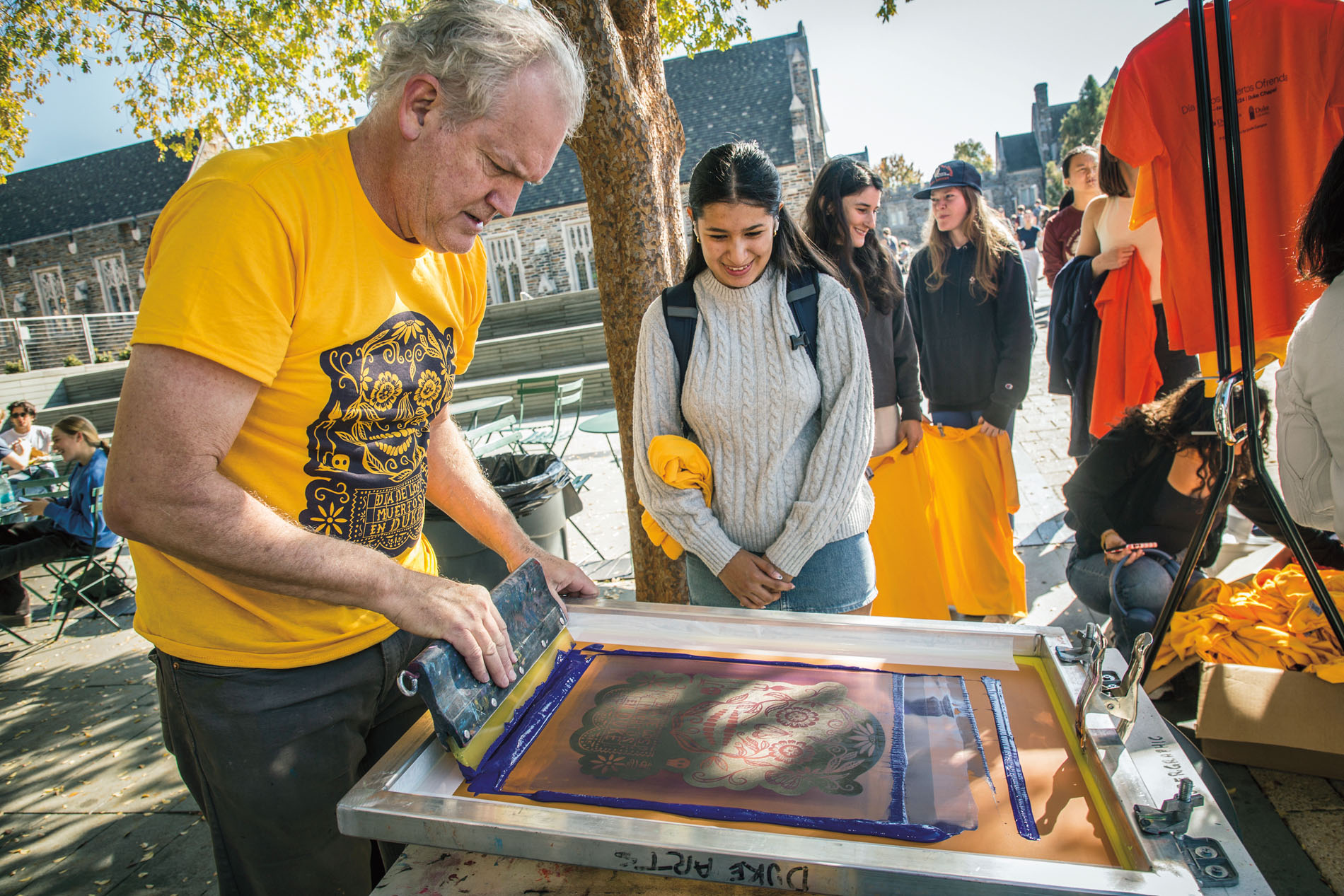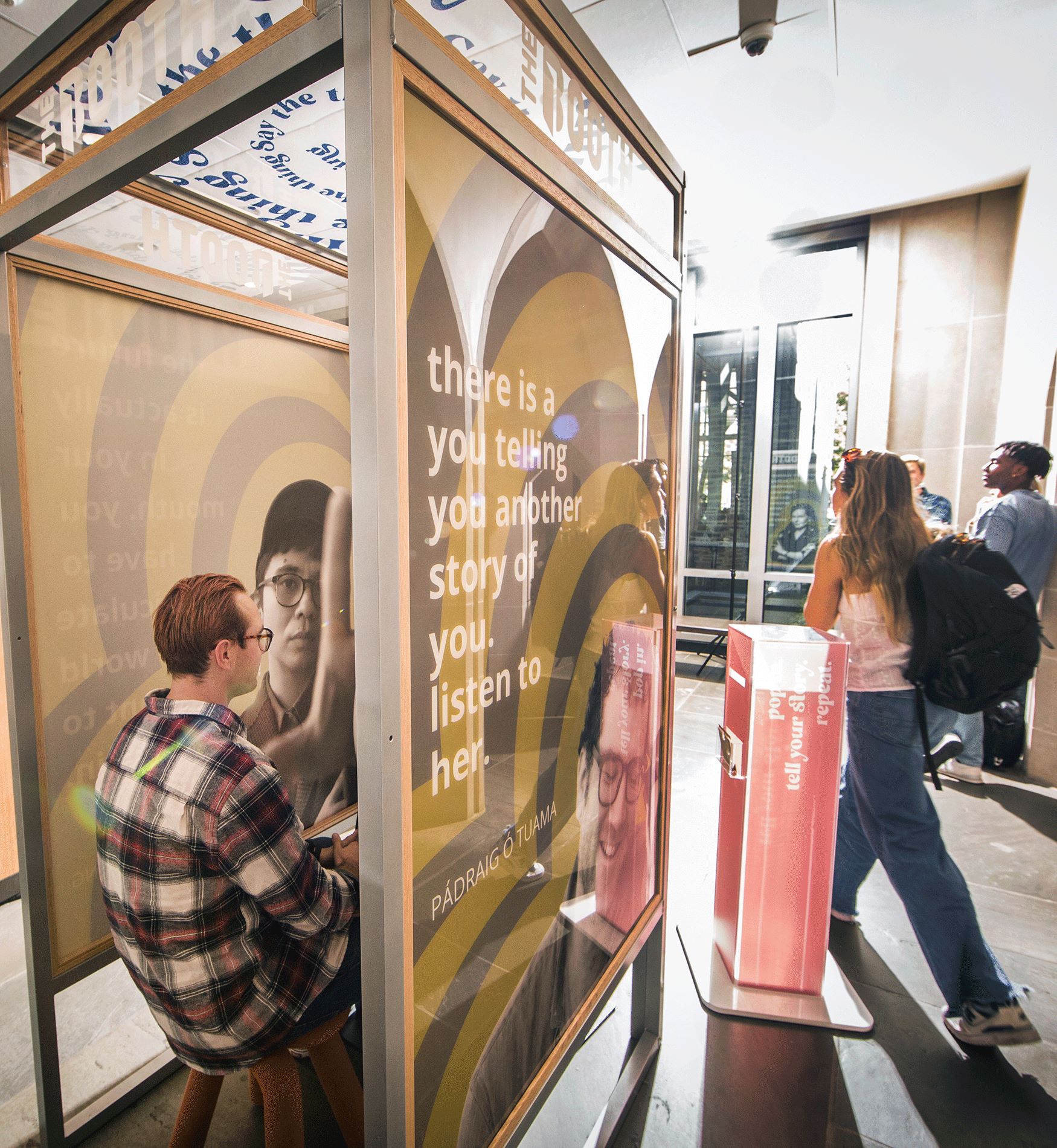It’s a busy lunchtime on the Bryan Center Plaza and the Rev. Leah Torrey, Duke Chapel director of special initiatives, is trying to change lives.
“Do you want a cupcake?” she asks passersby. “Do you want a sticker? Do you want to make a free poster? It takes two minutes!”
Well, who doesn’t? Torrey gives away plenty of cupcakes and has many takers for stickers. But the big event is the poster – an opportunity for students to reuse discarded sheets of music, on which they can ink up a stamp and print the face of a favorite modern musician (at this point the choices are Nina Simone, Mary Lou Williams, Beyonce, Joni Mitchell or Leonard Cohen), and then add to the piece with a sticker of some of the lyrics of any of the musicians.
Students try to rush by to lunch or class but are lured in: “Wait, sure!” one girl says. “This is so cool! My walls are bare!” In scarcely a moment students use a roller to ink a stamp, press it onto a sheet of music, and from there it’s up to them.

“We want their judgment to guide them,” Torrey says. “To make something with their own two hands and know the product is perfect, no matter how it is.”
Some just print a musician; some add the musician’s lyrics; others add lyrics from one of the other choices, or other stickers on offer. A few people have just taken a couple sheets of the music (Beethoven scores no longer needed by the Chapel), and that’s not only just fine with Torrey, it’s highly approved.
“They’re exercising their agency,” she says. This is a moment of pure choice, a moment of play, a moment of creativity. Whatever you do is right. It’s not an assignment for credit: “It’s a riff on what is your sacred music, what restores you to yourself?” Torrey says. “You can’t get an A in doing this.”
Which is the point of Say the Thing, the Chapel program putting on this Lark. (They call these craft events Larks – “a bit of sweet storytelling malarkey,” the program website says.) Torrey sets as a goal for Say the Thing to help students step outside their traditional Duke identities focused on grades and accomplishments. Say the Thing supports “the side of yourself that gets suppressed because you’re an econ major,” she offers. Say the Thing encourages students to remember that less-structured side of their lives – expressed in stories and play. It doesn’t contribute to GPA or the next internship, she says, but “that doesn’t mean it’s not valuable.” Say the Thing encourages that part to come out, for a moment or a month, for a single event or a series, alone or as part of a group.
Other Larks include blackout poetry (you black out words on a page until what’s left expresses something) and reuse of old book covers to make chains for the Dia de los Muertos ofrenda in the Chapel. Say the Thing is a group of programs, Torrey says, “and what sort of binds them all together is a focus on storytelling, moral agency, and ethical development.” Different programs allow participation by people with differing degrees of time, interest and commitment. There’s the Booth, in which a participant steps into a little booth and is videotaped responding to a prompt: “Your place to tell a story about yourself to yourself,” the website says. “You can go in for five minutes once and you’re done, or you can develop a relationship with it and come back over and over again,” Torrey says.
There’s the Studio, a six-week, once-a-week meeting of a group of people who talk and write in response to Torrey’s prompt, ultimately shared in a published work, and there’s the Hamster, a mostly solitary program in which you write about and provide photos of places that have had deep meaning for you – the house you moved away from, where you met your best friend, the flea market your family ran. Torrey responds, ultimately by creating photo-based images in response to your stories, which you can then share on the Say the Thing Instagram feed if you like. (All sharing or participation is voluntary, and there are no wrong answers. It’s a community, not a class.)

The program is all based on story, Torrey says. She joined Duke in 2022 after years in community activism and at the Dartmouth Center for Social Impact. The model for Say the Thing, with its focus on storytelling and on living the values we claim, comes from many sources but rests especially on the work of theologian and Civil Rights pioneer Howard Thurman. “A lot of his philosophy was this idea of two things around story: That story is this dynamic process, a deep internal understanding of who you are and who you hope to become; and then internal contemplation of whether your outward action matches the inward hope.”
That raises questions: “What if we could reframe a story of who we are? Does that unlock a new potential about who we can become? The story of our lives is the story of our values put into action.” It encourages people to stop and play, to stop and think.
It’s working. “This is beautiful!” says David Evans, a Divinity School grad student who stops by. “I was just going to eat – now I’ve got some spiritual food.” He used the stamp of Duke’s own jazz giant Mary Lou Williams: “I realize I feel better after doing that. I felt like I connected to Mary Lou Williams.”
The Rev. Dr. Luke Powery, dean of Duke Chapel, teaches a class on Thurman, and he connected with the Purpose Project, a Kenan Institute for Ethics program that asks questions about character and purpose. Staffs worked together and came up with Say the Thing, a project, Powery says, that focuses on “this idea of storytelling, helping young people come to who they are called to be – to be more fully human.” As he says, “something that would help people not just tell stories but come to voice.” Torrey was hired. “She’s the one that’s built it,” Powery says of Say the Thing.
Chloe Scott, a sophomore linguistics major, participated in one of last year’s Studios, and she liked it so much she comes to Larks to help now. “Leah would give us a prompt,” she recalls, usually a text from one of the writers they were reading for guidance on the concept of home. They would consider ideologies, thought processes – and home. Then they would write. Scott’s writing shows up in “our things, volume 1,” printed last year on entirely reused materials (discarded Chapel stationery, old library book covers). She loved bending her mind around these concepts, thinking about what made her herself and how to better understand that – and be true to it. Moreover, “It was just nice to be able to do it in an environment where there was no pressure, no grade.”
Torrey sees only growing interest in what Say the Thing has to share. A recent event at the Pratt School of Engineering had 150 participants doing blackout poetry, but she notes that a large group or large commitment aren’t the point.
“You can walk into story-centered self-reflection through any number of doors,” she says. You could be like Scott, who did the Studio, now helps with Larks, and is planning to do a Hamster. “She wants this ongoing experience. Or you could do one Lark for two minutes in your entire semester, but you’ve still engaged in an activity that helps you think deeply about your own story and how that connects to the broader story of your life.” You just have to say the thing.
